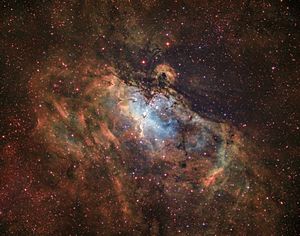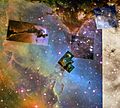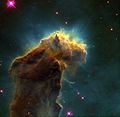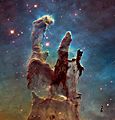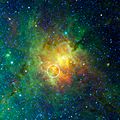Eagle Nebula facts for kids
| Emission nebula | |
|---|---|
| H II region | |

Three-colour composite mosaic image of the Eagle Nebula, with north at top. Credit: ESO
|
|
| Observation data: J2000.0 epoch | |
| Right ascension | 18h 18m 48s |
| Declination | −13° 49′ |
| Distance | 5,700±400 ly (1,740±130 pc) |
| Apparent magnitude (V) | 6.4 |
| Apparent dimensions (V) | 70 x 50 arcmins |
| Constellation | Serpens |
| Physical characteristics | |
| Radius | 70×55 (cluster 15) ly |
| Absolute magnitude (V) | -8.21 |
| Notable features | 1–2 million years old |
| Designations | Messier 16, NGC 6611, Sharpless 49, RCW 165, Cr 375, Gum 83, Star Queen Nebula |
The Eagle Nebula is a huge cloud of gas and dust in space. It is also known as Messier 16 (or M16) and NGC 6611. Sometimes, people call it the Star Queen Nebula.
This nebula is a place where new stars are being born. It contains a group of young stars called an open cluster. The Eagle Nebula is found in the constellation Serpens. A scientist named Jean-Philippe de Cheseaux first saw it in 1745 or 1746.
The names "Eagle" and "Star Queen" come from how parts of the nebula look. There's a dark shape in the middle that reminds people of an eagle or a queen. This area became very famous because of pictures taken by the Hubble Space Telescope. These pictures showed amazing structures called the "Pillars of Creation". The Eagle Nebula is located in the Sagittarius Arm of our home galaxy, the Milky Way.
Contents
What is the Eagle Nebula Like?
The Eagle Nebula is a type of cloud called an emission nebula. This means it glows because the gas inside it is heated by hot, young stars. It's also known as an H II region, which is a place where hydrogen gas is ionized (has its electrons stripped away).
This amazing nebula is about 5,700 light-years away from Earth. A light-year is the distance light travels in one year. That's a very long way!
One part of the nebula looks like a tall, thin tower of gas. This "spire" is in the northeastern section. It is about 9.5 light-years long. To give you an idea, that's about 90 trillion kilometers!
Stars in the Eagle Nebula
The group of stars inside the Eagle Nebula has about 8,100 stars. Most of these stars are gathered in a clear space within the gas cloud.
The brightest star in the cluster is called HD 168076. You can easily see it with good binoculars. This star is actually two stars orbiting each other, a binary star. Both are very hot and bright stars.
One of these stars is about 80 times bigger than our Sun. It shines up to a million times brighter than the Sun! Scientists believe this group of stars is quite young, only about 1 to 2 million years old.
The name "Star Queen Nebula" was suggested by Robert Burnham, Jr.. He thought the central pillar looked like a queen in silhouette.
The Famous "Pillars of Creation"
In 1995, scientists Jeff Hester and Paul Scowen used the Hubble Space Telescope to take incredible pictures of the Eagle Nebula. These images helped us understand how stars form. One picture, known as the "Pillars of Creation", became very famous. It shows a large area where new stars are being born.
What are the Pillars?
The Pillars of Creation look like giant fingers or towers sticking up from the nebula. They are made of cold hydrogen gas and dust. These pillars act like nurseries for new stars. Inside these columns, and on their surfaces, astronomers have found small, dense clumps of gas. These are called EGGs, which stands for "Evaporating Gaseous Globules". New stars are forming inside some of these EGGs.
Scientists have also used the Chandra X-ray Observatory to look at the Pillars. X-ray images show that young stars (which give off X-rays) are scattered throughout the nebula, but not directly inside the Pillars themselves. This means that any baby stars inside the EGGs are not yet hot enough to produce X-rays.
Will the Pillars Last?
In 2007, the Spitzer Space Telescope found hot gas near the Pillars. This suggested that a supernova (a huge star explosion) might have happened nearby. The explosion could have happened 8,000 to 9,000 years ago. The light from this explosion would have reached Earth about 1,000 to 2,000 years ago.
Scientists thought a slow-moving shock wave from the supernova might destroy the delicate Pillars. However, in 2014, the Hubble Space Telescope took new pictures of the Pillars. These new images, taken 20 years after the first ones, showed how fast the Pillars are slowly disappearing.
The good news is that there's no clear sign of a supernova destroying them. Scientists now believe the Pillars will likely last for at least another 100,000 years!
Gallery
See also
 In Spanish: Nebulosa del Águila para niños
In Spanish: Nebulosa del Águila para niños


